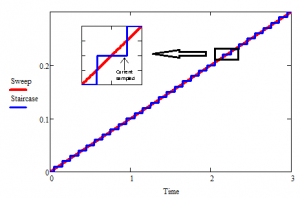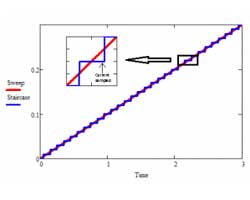Measuring Surface Related Currents
Using Digital Staircase Voltammetry
Introduction
Cyclic Voltammetry (CV) is unarguably the most popular electrochemical technique. It owes its well deserved reputation to its ability to deduce reaction mechanisms with relatively low cost equipment and quick experimentation. Since the very highly cited paper by Nicholson and Shain1 the technique has been the centerpiece of any electrochemical study.
CV involves sweeping the potential linearly between two limits at a given sweep rate while measuring current. The sweep rate chosen can be varied from few microvolts per second to millions of volts per second.
Electrochemical instrumentation has evolved vastly since the days of Nicholson and Shain. Currently, most manufacturers (including Gamry) make digital instruments with digital signal generators. These signal generators approximate the linear sweep with a staircase of variable step sizes and durations.

Figure 1 Staircase vs analog ramp

